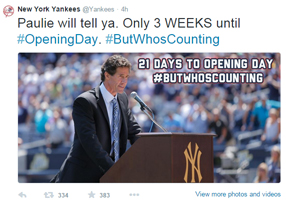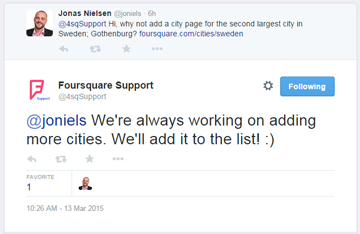Part two of a five-part series on social media for businesses. The series looks at each of the big five social media outlets (Facebook, LinkedIn, Pinterest, Instagram and Twitter), and the opportunities each offer to businesses to engage with customers and other stakeholders.
What it specializes in: 140 character “Tweets” allow users to share links, pithy observations, or direct questions to other users. Twitter is time and trend sensitive – it is focused on what is happening right now. Users look for breaking news, trending topics and real-time discussion of events as they happen. Unlike Facebook, most conversations on Twitter are among strangers rather than in-person friends or acquaintances.
Who uses Twitter: As of Sept. 2014, 19% of adults (and 23% of online adults) use Twitter. Of those, 36% use it daily, 24% weekly, and 40% less often. Twitter users are relatively evenly balanced between women and men and self-identify as 27% Black, 25% Hispanic, and 21% White. Thirty seven percent are 18-29 years old, 25% are 30-49, and 22% are 50 years old or older. Twitter skews toward higher income users with 54% earning $50,000 or more per year. (Source: Pew Research Center’s Internet Project September Combined Omnibus Survey, September 2014. http://www.pewinternet.org/2015/01/09/social-media…)
What kinds of businesses make the best use of Twitter? Twitter can be a powerful tool for any organization that produces regularly published content, is a thought leader in a particular area, or provides online customer service.
Below are some examples of companies, organizations and leaders that use Twitter particularly effectively.

Publishing:
One of the more straightforward uses of Twitter is to promote online content. Slate Magazine and Scientific American both provide a steady flow of links to their published articles. Scientific American also provides its followers with live updates on science related news.

Politics/Public Service:
Because of the time-sensitive nature of public policy debates, the political realm is particularly well suited for Twitter. Whether it be commenting in real time on a State of the Union Address or urging the public to support a particular cause, political leaders, lobbyists, and special interest groups, all can make effective use of the platform to engage constituents and influence public debate. In the examples below, Senator Cory Booker responds personally to constituents from his Twitter account. The Brennan Center promotes its public interest research and engages with users who tweet about related issues. And the American Foundation for Equal Rights posts exclusively about Marriage Equality.
- Senator Cory Booker
- The Brennan Center
- Twitter case study on how the American Foundation for Equal Rights influenced the national conversation on marriage equality

Sports:
Sporting events lend themselves well to real-time commentary and conversations, and organizations that provide entertaining commentary can figure prominently in those conversations through wise use of hashtags. In the examples below, the New York Yankees provide a steady flow of information, photos, video clips and real-time updates about the team. “Nunes Magician” is the alias of author and blogger, Sean Keeley, who tweets about all things Syracuse University (SU) Athletics. Keeley and his associates maintain a loyal following (and generate book sales), by providing humorous commentary during and around SU sporting events.

Providing real-time customer service is perhaps the strongest reason to have a presence on Twitter. Companies that are able to respond directly and publicly to those requesting support, or publicly complaining about a product or service, can take a potentially negative situation and transform it into a positive one with excellent customer service. In the examples below, both Adobe and Zappos interact directly with customers to resolve issues. 5LINX Support uses a similar approach to provide information for their direct marketing affiliates.
Should I be worried about using Twitter?
Twitter has a tendency to produce some acidy commentary, including outright abuse, so it is not right for every organization. For some examples, see Jimmy Kimmel’s running bit, “Mean Tweets”, in which celebrities read aloud some of the insults that people posted about them on Twitter. Extreme care should be taken promoting anything on Twitter that relates to specific individuals who might be vulnerable to that kind of online abuse, especially children.
Furthermore, even a moment’s lapse in common sense can be preserved forever. Just ask Justine Sacco, a PR professional who was subjected to an outpouring of vitriol, and the loss of her job over an ill-considered joke. Anthony Weiner also famously ended his career in the United States Congress by confusing the option for sending a private message to a particular user, with the option for sending a public tweet, thus posting a photo of himself in his underwear to all of his followers, instead of to the person with whom he was illicitly chatting.
Some lessons to keep in mind:
- Choose wisely when selecting individuals you authorize to tweet on behalf of your organization. Make sure they are people who are media savvy, and whose judgment you trust.
- Think very carefully before promoting tweets about individuals who might be vulnerable to unwanted negative attention.
- Consider that written comments can be easily misinterpreted when read out of context, or by people who don’t know you or your organization. Review your own Tweets with this in mind before Tweeting.
Learn more:



